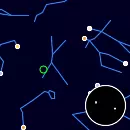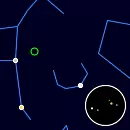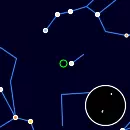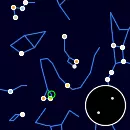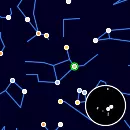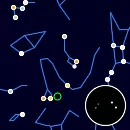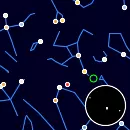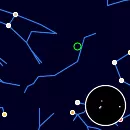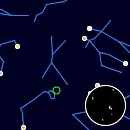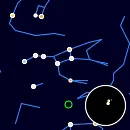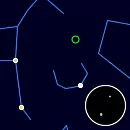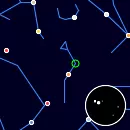Binocular Double Stars Visible Tonight: Stunning Pairs Revealed Through Binoculars
Sky Map
Celectial bearing and elevation at 04:01
Binocular double stars are pairs of stars that can be seen clearly through binoculars. They often exhibit wide separations and striking color contrasts. Examples include the famous pair of Algieba in Leo and the colorful pair of Epsilon Lyrae in the Lyra constellation. These systems are ideal for amateur astronomers using binoculars.
08572+1519
Double Star
Double star system in the constellation Cancer with primary and secondary components of magnitudes 5.24 and 5.70, separated by 16.3 arcminutes.
16224+3348
Multiple Star System
6-star star system in the constellation Corona Borealis with primary and secondary components of magnitudes 5.39 and 5.58, separated by 6.2 arcminutes.
13101+3830
Triple Star System
Triple star system in the constellation Canes Venatici with primary and secondary components of magnitudes 5.95 and 6.26, separated by 4.8 arcminutes.
17322+5511
Double Star
Double star system in the constellation Draco with primary and secondary components of magnitudes 4.87 and 4.90, separated by 1.2 arcminute.
12021+4303
Multiple Star System
7-star star system in the constellation Ursa Major with primary and secondary components of magnitudes 5.24 and 6.72, separated by 5.3 arcminutes.
12417-0127
Multiple Star System
9-star star system in the constellation Virgo with primary and secondary components of magnitudes 3.48 and 3.53, separated by 6.5 arcseconds.
12289+2555
Multiple Star System
7-star star system in the constellation Coma Berenices with primary and secondary components of magnitudes 5.23 and 6.64, separated by 2.4 arcminutes.
12413-1301
Multiple Star System
Quadruple star system in the constellation Corvus with primary and secondary components of magnitudes 5.88 and 5.89, separated by 6.9 arcseconds.
12492+8325
Triple Star System
Triple star system in the constellation Camelopardalis with primary and secondary components of magnitudes 5.29 and 5.74, separated by 22 arcseconds.
17053+5428
Multiple Star System
Quadruple star system in the constellation Draco with primary and secondary components of magnitudes 5.66 and 5.69, separated by 4.4 arcseconds.
16081+1703
Triple Star System
Triple star system in the constellation Hercules with primary and secondary components of magnitudes 5.10 and 6.21, separated by 40 arcseconds.
17419+7209
Multiple Star System
6-star star system in the constellation Draco with primary and secondary components of magnitudes 4.60 and 5.59, separated by 32 arcseconds.
08467+2846
Double Star
Double star system in the constellation Cancer with primary and secondary components of magnitudes 4.13 and 5.99, separated by 31 arcseconds.
07229+5517
Multiple Star System
Quadruple star system in the constellation Lynx with primary and secondary components of magnitudes 5.76 and 6.71, separated by 14.2 arcseconds.
08358+0637
Multiple Star System
9-star star system in the constellation Cancer with primary and secondary components of magnitudes 5.98 and 7.16, separated by 12.5 arcseconds.
14407+1625
Triple Star System
Triple star system in the constellation Bootes with primary and secondary components of magnitudes 4.88 and 5.79, separated by 7 arcseconds.
11182+3132
Multiple Star System
5-star star system in the constellation Ursa Major with primary and secondary components of magnitudes 4.33 and 4.80, separated by 2.6 arcseconds.
15394+3638
Double Star
Double star system in the constellation Corona Borealis with primary and secondary components of magnitudes 4.96 and 5.91, separated by 5.5 arcseconds.
06462+5927
Multiple Star System
5-star star system in the constellation Lynx with primary and secondary components of magnitudes 5.44 and 6.00, separated by 2.5 arcseconds.
15348+1032
Multiple Star System
5-star star system in the constellation Serpens with primary and secondary components of magnitudes 4.17 and 5.16, separated by 3.4 arcseconds.

